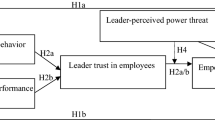Abstract
When it comes to senior executives in the US federal government, it seems the old adage is true: there is always room for improvement. Results from the 2012 Federal Employee Viewpoint Survey (FEVS) reveal that on key measures of leadership, just over half of federal employee respondents agree that their organizational leaders promote communication among different work units (53.2 percent agree), support collaboration across work units to accomplish objectives (56.9 percent agree), or maintain high standards of honesty and integrity (55 percent agree). Less than half of survey respondents believe that leaders generate high levels of motivation and commitment in the workforce (43 percent agree) and only 57.9 percent of respondents think their senior leaders are doing a good job. Clearly, these results present a challenge and an opportunity for learning and change.
Access this chapter
Tax calculation will be finalised at checkout
Purchases are for personal use only
Preview
Unable to display preview. Download preview PDF.
Similar content being viewed by others
References
Bonosaro, C. A. (2009). “Putting People First: A Way Forward for the Department of Homeland Security Workforce.” Testimony Before the House Subcommittee on Management, Investigation, and Oversight. March 5.
Caldwell, P. (2000). “Adult Learning and the Workplace.” In Training in the Workplace: Critical Perspectives on Learning at Work, ed. by H. Rainbird. New York: St. Martin’s Press.
Carey, M. P. (2012). “The Senior Executive Service: Background and Options for Reform.” Congressional Research Service. 7–5700. Retrieved via www.crs.gov.
Dipboye, R. L. (1997). “Organizational Barriers to Implementing a Rational Model of Training.” In Training for a Rapidly Changing Workplace, ed. M. A. Quinones and A. Ehrenstein. Washington, DC: American Psychological Association.
Dixon, K., and Temple-West, P. (2013). “IRS Officials Try to Tame Conference Spending Scandal.” Reuters. June 6.
Federal Executive Institute (undated). “Onboarding for New SES Members.” Retrieved from http://www.leadership.opm.gov/fei/SESOnboarding/index.aspx.
Hansen, K. (2013). “From Theory to Practice: The Federal Executive Board; Leadership in Action.” PublicAdministration Review 73(4): 565–566.
Hicks, G. (2012). “Collaborating to Tackle Government’s Challenges.” V/Anguard. July/August.
Hollenbeck, G. P., and McCall, M. W. (2003). “Competence, Not Competencies: Making Global Executive Development Work.” Center for Effective Organizations Report 03–15(443). March.
Ingraham, P. W. (1995. The Foundation of Merit: Public Service in American Democracy. Baltimore, MD: Johns Hopkins University Press.
Ink, D. (2007). “Twenty-First-Century Career Leaders.” In Transforming Public Leadership for the 21st Century, ed. R. S. Morse, T. F. Buss, and C. M. Kinghorn. Armonk, New York: M. E. Sharpe.
Lunney, K. (2013). “Frustrated Senior Execs Sound Off on Sequestration.” Government Executive, August 7.
McElhatton, J. (2012). “GSA Scandal Widens; Dozens of Conferences Now under Investigation.” Washington Times, August 1.
O’Leary, R., and Gerard, C. (2012). Collaboration across Boundaries: Insights and Tips from Federal Senior Executives. Washington, DC: IBM Center for the Business of Government.
Organisation for Economic Co-operation and Development (OECD). (2001). Public Sector Leadership for the 21st Century.
Partnership for Public Service (2013). Building the Leadership Bench: Developing a Talent Pipeline for the Senior Executive Service.
Partnership for Public Service (2012). Mission-Driven Mobility: Strengthening Our Government through a Mobile Leadership Corps.
Partnership for Public Service (2009). Unrealized Vision: Reimagining the Senior Executive Service.
Pollitt, C., and Op de Beeck, L. (2010). “Training Top Civil Servants: A Comparative Analysis.” Report. Leuven, Belgium: Public Governance Institute:
Sandberg, J. (2000). “Competence: The Basis for a Smart Workforce.” In Training for a Smart Workforce, ed. R. Gerber and C. Lankshear, London: Routledge.
Schein, E. H. (2010). Organizational Culture and Leadership. 4th ed. San Francisco: Jossey-Bass.
Sherwood, F. (2010). “The Early Federal Executive Institute: A University-Style Resource for Senior Federal Executives.” In The Early Years of the Federal Executive Institute: Theory, History, Reflections, ed. by F. P. Sherwood. Bloomington, IN: iUniverse.
US Office of Personnel Management (2010). FedScope database. Retrieved from http://www.fedscope.opm.gov.
US Office of Personnel Management (2012). Executive Development Best Practices. November.
US Office of Personnel Management (2013). 2012 Senior Executive Service Report. March.
Van Wart, M. (2013). “Lessons from Leadership Theory and the Contemporary Challenges of Leaders.” Public Administration Review 73(4): 553–564.
Van Wart, M. (2008). Leadership in Public Organizations: An Introduction. Armonk, NY: M. E. Sharpe.
Van Wart, M., Cayer, N. J., and Cook, S. (1993). Handbook of Training and Development for the Public Sector: A Comprehensive Resource. San Francisco: Jossey-Bass.
Zients, J. D., and Berry, J. (2011). Memorandum for the Senior Executive Service: Senior Executive Service Initiative. February 18.
Editor information
Editors and Affiliations
Copyright information
© 2015 Heather Getha-Taylor
About this chapter
Cite this chapter
Getha-Taylor, H. (2015). The United States of America. In: Van Wart, M., Hondeghem, A., Schwella, E., Suino, P. (eds) Leadership and Culture. Governance and Public Management Series. Palgrave Macmillan, London. https://doi.org/10.1057/9781137454133_4
Download citation
DOI: https://doi.org/10.1057/9781137454133_4
Publisher Name: Palgrave Macmillan, London
Print ISBN: 978-1-349-49787-4
Online ISBN: 978-1-137-45413-3
eBook Packages: Palgrave Political Science CollectionPolitical Science and International Studies (R0)




